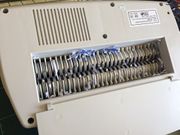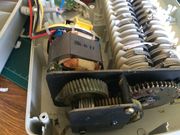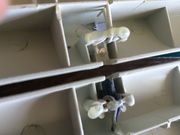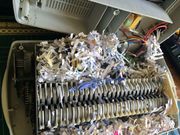Paper shredders: Difference between revisions
No edit summary |
|||
| Line 31: | Line 31: | ||
Jams are very common, and may be due to feeding too much paper in at once or a foreign object such as a paper clip. If you continue to feed paper in when the bin is already full, it is likely to get wrapped around the cutters and eventually jam. Some shredders are designed to take CDs and DVDs, but feeding one into a shredder which is not designed to take it may well cause a jam or the motor to overheat. | Jams are very common, and may be due to feeding too much paper in at once or a foreign object such as a paper clip. If you continue to feed paper in when the bin is already full, it is likely to get wrapped around the cutters and eventually jam. Some shredders are designed to take CDs and DVDs, but feeding one into a shredder which is not designed to take it may well cause a jam or the motor to overheat. | ||
[[File:Shredder_cover_off.jpg|180px|thumb| | [[File:Shredder_cover_off.jpg|180px|thumb|right|The underneath of a domestic cross-cut shredder with the cover off.]] | ||
Double-check that the device is unplugged before starting disassembly or going anywhere near the cutters. The first thing to do is often to remove as much shredded paper from the cutters as possible, which may have got all over the inside. Often, it gets wrapped around them. If there's any other cause of a jam you should now be able to see it. | Double-check that the device is unplugged before starting disassembly or going anywhere near the cutters. The first thing to do is often to remove as much shredded paper from the cutters as possible, which may have got all over the inside. Often, it gets wrapped around them. If there's any other cause of a jam you should now be able to see it. | ||
Revision as of 19:43, 28 May 2020
This page covers the mechanical and electrical problems that can arise with domestic paper shredders.
Summary
Paper shredders are simple electromechanical devices but a fairly powerful motor is required to operate the shredding mechanism, and that power can break things internally. Problems can be divided into mechanical and electrical, but your first task might be to determine which it is in your particular case.
Safety
- Always unplug before opening the device. It could be very dangerous to operate whilst partially disassembled.
- Keep fingers, hair and loose clothing well away from the mechanism.
Principles of operation
There are two types of shredder: strip-cut and cross-cut. Strip-cut shredders simply cut the paper into narrow strips which, with patience, could be reassembled. Cross-cut shredders are considerably more secure as these chop each strip into many short sections.
The shredding action is accomplished by two interlocking sets of circular cutterrs which rotate in opposite directions. The paper is drawn in between them so cutting it into strips. In a cross-cut shredder, the circular cutters also have spikes which break up each strip.
The cutters are driven by a fairly powerful motor (always an AC/DC motor) through a gear chain to reduce the speed and increase the torque. A switch controls power to the motor. This is normally a 3 position switch with off, forward and reverse positions. The reverse position can be used in the case of a jam, to feed the paper back out again. In this position, the connections are reversed either to the field winding or to the brushes of the electric motor, causing it to run backwards.
There are likely to be one or more safety interlocks. A mechanical or optical sensor generally detects when a piece of paper is inserted into the feed slot, only allowing the motor to run when this happens. A microswitch may disable the motor if the shredding head is not positioned correctly on the bin. A small circuit board will probably interconnect these features, the motor, the main switch and probably a power indicator light. There may be a mains filter to prevent voltage spikes generated by the motor causing problems for other equipment on the same mains supply.
Problems are most commonly caused by demanding too much of the shredder, whether too many sheets at once, unsuitable materials, or heavy use for too long at a time. A poor quality shredder may simply fail with only moderate use.
Heavy duty and commercial shredders require regular oiling. This might be beneficial for domestic shredders but if you do, only use special shredder oil. Never use WD40 as this is not a lubricant. Vegetable oils (icluding olive oil) may go rancid, and any oil of an unsuitable type is likely to clog the mechanism with oily paper and make matters worse.
You will find a vacuum cleaner useful, or at least a dustpan and brush, to clear up the bits of shredded paper that will inevitably spread themselves around.
Mechanical problems
Jams are very common, and may be due to feeding too much paper in at once or a foreign object such as a paper clip. If you continue to feed paper in when the bin is already full, it is likely to get wrapped around the cutters and eventually jam. Some shredders are designed to take CDs and DVDs, but feeding one into a shredder which is not designed to take it may well cause a jam or the motor to overheat.
Double-check that the device is unplugged before starting disassembly or going anywhere near the cutters. The first thing to do is often to remove as much shredded paper from the cutters as possible, which may have got all over the inside. Often, it gets wrapped around them. If there's any other cause of a jam you should now be able to see it.
Not uncommonly, a jam or heavy use can cause one of the gear wheels to be stripped. This should be obvious, but unfortunately this is not usually fixable.
Electrical problems
Unless the problem is visually obvious, you will need a multimeter and probably a basic understanding of AC/DC motors.
If there is no life in the shredder the first thing to check is the fuse in the plug. This isn't often the problem but is very easily checked. There may be another fuse within the device. Also check that the lead is in good condition, the plug is correctly fitted and there are no loose connections.
It's possible the motor may have burnt out, in which case signs of overheating may or may not be obvious. Even if it looks good, use a multimeter to check the resistance of the motor field windings and the resistance of the rotor measured between the brushes. Check that the commutator is clean and not pitted from sparking, and that the brushes are in good order.
There may be a thermal cutout attached to or inside the motor which could have tripped. If it's open circuit and provided it's accessible it should be replaceable, though it may not be easy to work out what temperature rating the replacement should have.
Problems with the paper detect mechanism are fortumately fairly unusual as they may not be easy to detect or diagnose unless indicated by obvious burning or a swollen electrolytic capacitor.
If the problem is still not apparent you should start by checking for continuity from the plug, through the switch and the motor, and back to the plug.



